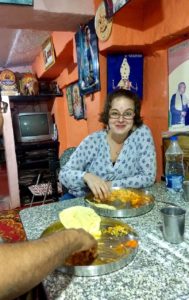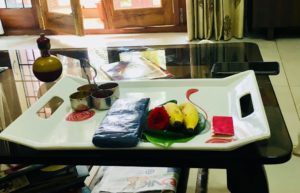I imagine India as blazing hot. How’s the weather?
It’s true that most of India is blazing hot, but there are a couple places in the country with more moderate weather. Bangalore is one of those places. The summer months of March and April will see average highs of 93 degrees. We are currently LOVING the highs in the mid-80s and nighttime/morning temps of 67.
We are nearing the end of this monsoon season (we’re expected to get tons more rain in September), so a few times a week we receive a heavy rain that pops up out of nowhere. (Lesson: always carry an umbrella.)
What’s been the hardest adjustment?
I’m used to being far away from the majority of my friends, so this isn’t unusual. But I’m still missing my frequent in-person girl time. I also miss sharing time with my mom and Saira together.
It’s not easy taking care of official business. Example: A simple task to upload documents to the government immigration office took five days, two phone calls, and a four-hour excursion to the immigration office which included conversations with three officers and a trip to an Internet cafe guy in the bus terminal where we had to pay him to upload the documents.
Has your wardrobe changed since moving to India? What do you wear on a typical day – work day and then weekend?
So far, the additions to my wardrobe include two great pairs of jeans I bought at a mall last weekend. On a typical work day, I wear my Western business/casual clothes. At home and on the weekends, I’m living in jeans, yoga pants, t-shirts. I also wear my Indian kurtas (shirts), and I’m building my Indian wardrobe too.
How does medical care work? Is it similar to the US?
My experience with medical care is limited to Saira’s pediatrician and vaccines.
Based on the disease burden of India, the vaccine schedule here is accelerated. By 14 weeks of age, babies have the vaccines of a 6-month-old in the States. One additional vaccine here in India is a TB vaccine given at birth.
Our visits are pretty typical. We take an Uber to the doctor’s office which is on the second floor of a nearby hospital. The doctor is waiting for us in the room. Saira gets weighed and measured and he checks in with us on any questions we have. (We have to carry with us his notes from her previous visit as they are not stored electronically.)
He goes over the dosages and shows us the expiration dates on the vaccines. Some of the vaccine brand names are different from the US and he explains all of that. (These vaccines are imported from France.)
After we’re finished, we go to the cashier to pay cash. Our first visit, including consult fee, TB vaccine, and Vitamin D supplement cost $11 (that’s about how much we paid for our after-visit coffees). Her second visit was $147 because he used vaccines imported from France that are the same brands as the US. Vaccines are typically free in India.
In the evenings, our pediatricia sees patients at his home office, and he gave us his WhatsApp number so we can text him if anything comes up.
He hasn’t judged me for letting Saira find comfort in sucking my pinkie finger.
How can we best support you and yours as you’re expats?
It might be easy to think that we’re living an exciting and exotic life in India, but most of our daily moments are filled with the same mundane tasks we all busy ourselves with. That means I want to hear about your days and all of life’s simplicities and adventures.
What are your tricks to being a new mom, in a new country with a new job?
This will be a blog post of its own eventually, but there are a few things I’ve narrowed it down to:
Holding onto things loosely (except the kid. ![]() ) Things = expectations or set ways of doing things. Minor example: diapers here are different. We’ll all survive that.
) Things = expectations or set ways of doing things. Minor example: diapers here are different. We’ll all survive that.
Being open with people. I told another mom recently (we met at a friend’s party) that I forgot where I put Saira the other morning and panicked when I didn’t see her in her bassinet. She was like, “ME TOO! Mine’s started walking and leaves our bedroom on her own now. It scares me every time.”
I am also aware of my own naiveté, which I think is helpful in carving out our own normal.
Have you had any fun snacks? Any new foods?
 This picture depicts my favorite food experience so far.
This picture depicts my favorite food experience so far.
We spent the day driving out of the city and up a mountain to Nandi Hills. At the top of the mountain there’s a temple and in the temple is the main priest who is a relative of my in-laws. He and his wife were expecting us and insisted that we stay for lunch.
The food was delicious, yes, and despite the fact that I couldn’t understand a bit of the conversation, their graciousness and hospitality in their simple 1,000-year-old home is what makes this my favorite food experience thus far. It’s also the first Indian meal I’ve eaten with my hands, even though I’ve been in this family for four years.
Oh, and it’s also the first time I’ve realized how delicious ghee makes … everything? I’ve always been judicious in how much I consumer, but the priest served it up without any concern of arteries or calories. Mind blown.
What local customs and traditions have you learned about since you arrived?
When you (a woman) visit a friend or relative’s home, the woman of the house will bring you a gift in the spirit of hospitality and blessing. There’s kum kum powder for bindi, fruit and flowers on a betel leaf and most often fabric to sew a blouse for a saree. This is a picture I took when I visited a new friend in our apartment complex.
Also, there are a lot of religious holidays and festivals that are acknowledged by the society-at-large, so between Christianity, Hinduism and Islam, it seems we’re all celebrating something very often. For example, most recently was Eid, then a Hindu pooja and next week there is a Catholic holiday.
What’s coffee like?
Coffee is readily available in local grocery stores and at small vendors. “Coffee grounds” = “coffee powder” and a lot of times it’s mixed with chicory. We had to search awhile for a coffee maker because a lot of people use a French press (commonly called a “coffee filter”.) Tea is still most often the hot beverage of choice for lots of people. Starbucks is here, but the chain most frequently seen is Cafe Coffee Day (aka: CCD).
Tell me about the difference in diapers.
 These diapers are Huggies brand and you can see that they have elastic for the waist, resembling pull-ups or underwear.
These diapers are Huggies brand and you can see that they have elastic for the waist, resembling pull-ups or underwear.
It’s really hard to get a three-month-old’s legs through these and then pull them up properly.
There’s also no way to wrap the dirty diaper up and then fasten it closed with the velcro-ish tabs that we’re used to.
This particular size is for babies 8 to 17 pounds, so right now these are quite big for her. Price-wise, we got 76 diapers for 588 rupees, which is about $8.39.
We’ll do some more searching and see if we can find diapers with the velcro-ish tabs, but right now, we have about 50 of these left.
Where do you get drinking water?
We buy drinking water in five-gallon jugs from the convenience store in our complex (they deliver it) and then we pour it into this stainless steel container. Each jug costs Rs85 ($1.20). One lasts us about a day and a half.
Any more questions? Ask in the comments!

Comments